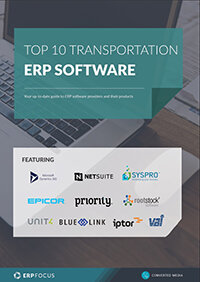Five warehouse automation and technology tips
When small to mid-sized merchants think of ways in which they can improve their use of technology within the warehouse, thoughts of Amazon, their 30,000 robot pickers and how it can seem tough to keep up with big brands like this can sometimes spring to mind. At Brightpearl, we believe retail and wholesale can (and should) be automated for SMEs as well. Here are some of our thoughts on how you can use technology in the warehouse to improve your operational efficiency and other associated order workflows.
1. Speed up processing times with barcode scanners
Using barcode scanners within the warehouse enables your staff to speed up order processing times as they will no longer be required to manually enter numbers. Seems pretty simple, doesn’t it? Barcode scanners also have the advantage of reducing the risks of injected errors, which drastically improves your perfect order rate as well. In this modern world, you should expect to source bluetooth barcode scanners, ensuring your staff don’t become tied down (or slowed down) by cords and wires.
2. Reduce errors with Electronic Data Interchange (EDI)
Electronic Data Interchange (EDI) is “the computer-to-computer exchange of documents in a standard electronic format between business partners.”
EDI can be used in a variety of ways within retail and wholesale businesses - especially within the warehouse - and its benefits are wide ranging. Here are a few ways EDI can help you with your own warehouse processes:
- It prevents mispicks or incorrect items from being sent out
- It reduces the number of missed deliveries
- It can track, monitor and chase delays with suppliers
- It prevents double selling of your inventory
- It automatically sends tracking information to your customers
Guide: seven steps to selecting distribution ERP
There are a number of EDI providers and companies out there who can help you to get started with EDI and offer guidance for what else you can do with it. It’s a reliable and advanced technology type so it can offer so much more than just the above list.
3. Automate your shipping with shipping integrations
Within your business management systems, you should be able to automate your shipping through the use of leading integrations to carriers like DPD, UPS and Fedex. This ensures your end-to-end order process is fully automated (especially when combined with automated order processing, which we will cover shortly).
Integrated shipping carriers allow your warehouse team to instantly print shipping labels and manifests, whilst automatically alerting carriers that a shipment needs to be charged for and picked up. To cover all areas, you should ensure that the shipping integration you use also has the ability to circle back around to your central management system to reflect the current status of the order, and automatically send out tracking references to customers.
With all of this combined together, your order processing times will be slashed, and all packages will be sent out with the correct shipping method based on things like package weight, volume, value or delivery address.
4. Free up time with automation bots
In aid of automating your end-to-end processes, automation bots can be used in combination with integrated shipping to handle order creation, inventory reservations, fulfillment and even invoicing. In short, automation bots help more than just your warehouse staff!
Imagine this workflow:
- Orders placed via your online sales channel, in-store or over the phone are all combined in one central system. (If your online and point of sale are integrated, these orders should be created automatically in your systems.)
- Orders are instantly allocated and fulfilled based on a set of rules you’ve chosen, such as the order is paid and enough on-hand inventory is available.
- The order statuses are automatically set to “Ready for despatch” or similar, ensuring your warehouse team are alerted when orders are ready to be picked, packed and shipped.
Notice how in this perfect workflow, there are a few stages where a “middle person” is cut out of the process, such as during the order creation, inventory allocation and order fulfillment stages.
Automation bots offer you and your team the chance to manage only by exception, thus, freeing up vital hours to be spent on the physical pick and pack stages. Ultimately, we know that the more orders you can get out of the door, the more customers you’ll satisfy and more sales you will drive.
It would be worth saying at this point that there are some risks involved with automating workflows. This expert guide covers these in detail, whilst highlighting more opportunities for where processes can be automated, thanks to bots.
5. Improve your order fulfillment latency with WMS
On the surface, this one seems pretty simple, but you may be surprised to know that we still hear of SMEs who haven’t yet adopted a paperless warehouse.
Integrated warehouse management systems (WMS) allow your staff to easily scan goods in and out of the warehouse, update inventory levels and perform inventory counts quickly using a barcode scanner. Each of these processes then, in turn, update your business management systems that are integrated with your WMS, ensuring your staff no longer have to update multiple systems or do things manually.
As can be expected, the benefits involved with WMS are to help reduce mispicks and save time, whilst improving both your order fulfillment latency and perfect order rate.
Similarly to EDI, there are a number of different warehouse management systems you can choose from. Our advice would always be to ensure the WMS is built for your industry, integrates well with the rest of your business and is cloud-based for ease of access (and in case you outsource your warehouse).
A final note on measuring effectiveness
If you decide to implement any of these technologies within your own warehouse, ensure you keep an eye on your operational KPIs, such as your perfect order rate, processing cost per order and order fulfillment latency. This will help you to establish the ROI for each new technology you implement, ideally ensuring you can secure more funding for further improvements in the warehouse and related processes.
Free white paper

7 steps to selecting distribution ERP
Get expert advice on distribution ERP selection and requirements analysis

Featured white papers
-

Top 10 Distribution Software Comparison
Compare the best distribution ERP systems available today
Download -

Top 10 Transportation ERP Software Comparison
Get your free comparison of the top 10 transportation ERPs
Download -

7 steps to selecting distribution ERP
Get expert advice on distribution ERP selection and requirements analysis
Download
Related articles
-

ERP for Food Distributors: Key Functionality
In a modern world where products are tailored to consumers, why should ERP for food distributors ...
-

Secret KPI: Why Your ERP Implementation Team Matters More Than Software
Learn how Godlan ensures successful ERP implementation for manufacturers with proven strategies &...
-

ERP & Logistics: Optimizing the Supply Chain
Read about the steps you can take to optimize your supply chain through ERP software logistics ma...

